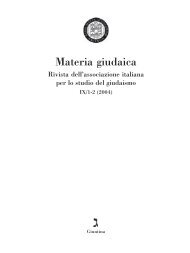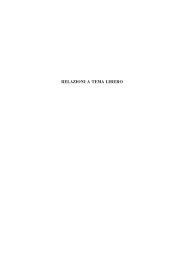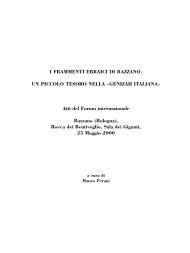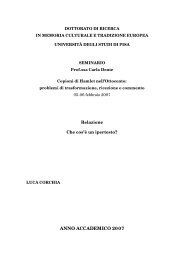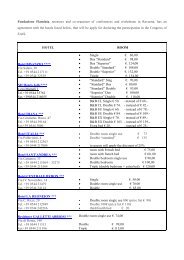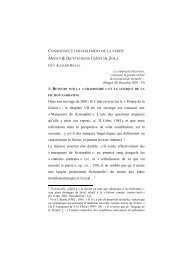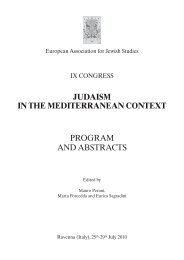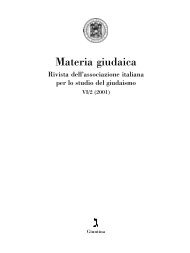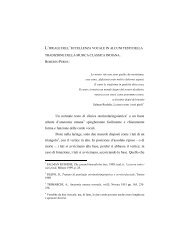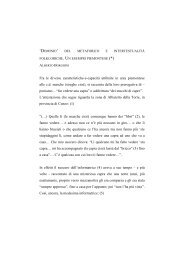161 Abraham Gross GERONA: A SEPHARDIC CRADLE OF ...
161 Abraham Gross GERONA: A SEPHARDIC CRADLE OF ...
161 Abraham Gross GERONA: A SEPHARDIC CRADLE OF ...
You also want an ePaper? Increase the reach of your titles
YUMPU automatically turns print PDFs into web optimized ePapers that Google loves.
<strong>Abraham</strong> <strong>Gross</strong><br />
This is just as accurate if we examine Gerona in<br />
terms of its influence on the history of religious<br />
mentality of Sephardic Jewry.<br />
For example, while the Zohar – apparently a<br />
Castilian creation – is undisputedly the one single<br />
most influencial medieval qabbalistic corpus, one<br />
should consider the following remarks by G. Scholem:<br />
«The most important period in the history of the<br />
older Kabbalah is linked up with the little Spanish town<br />
Gerona in Catalonia, where a whole group of mystics<br />
were active in the first half of the thirteenth century;<br />
this group was also the first which succeeded in familiarizing<br />
influencial circles of Spanish Jewry with Kabbalist<br />
thought. It was mainly their spiritual heritage<br />
that was brought to the fore in the Zohar» 4 .<br />
«[...] and in particular he (i.e. Moses de Leon) has<br />
drawn freely upon the writings published by the school<br />
of Kabbalists whose center was the little Catalan town<br />
of Gerona and who between the years 1230 and 1260<br />
did more than any other contemporary group to unify<br />
and consolidate what was pregnant and living in the<br />
Kabbalism in Spain. There can be no doubt that the<br />
writings of Ezra ben Solomon, Azriel and of Moses ben<br />
Nahman, the leading figure of this group, influenced<br />
him not only generally but also down to certain peculiar<br />
details of his own doctrine» 5 .<br />
This circle imported to Spain the esoteric<br />
teachings of their Provencal masters, interpreted<br />
them, and developed their ideas. As we shall see<br />
in other fields as well, Gerona, due to its location<br />
served as a virtual station which transmitted<br />
Northern knowledge and teaching into Spain, and<br />
itself transformed in the process 6 .<br />
Now, it might be futile to try and look for a<br />
trend which characterizes the famous outstanding<br />
figures of Gerona in the span of a century.<br />
Let us nevertheless attempt to evaluate in broad<br />
strokes some of the major figures; Jonah Gerondi,<br />
Moses ben Nahman (Nahmanides), and Nissim<br />
Gerondi.<br />
Jonah Gerondi, a prolific writer, who wrote<br />
in the beginning of the period defined above, affords<br />
us a comprehensive look into a figure of<br />
tremendous influence on Spanish Jewry.<br />
It is well-known that there are three criteria<br />
by which one evaluates real estate property;<br />
location, location, and location. When we<br />
described above the geographical location of<br />
Gerona it was not unintended. One of the major<br />
considerations a cultural historian must take<br />
into account in his attempt to describe and characterize<br />
a cultural center is its geographical location<br />
7 . Now, it is widely recognized that a rough<br />
cultural division must be made during this period<br />
between two major spheres of influence -<br />
Northern France and Spain. Between these two<br />
lies Provence, which characteristically draws<br />
from both and demonstrates it in a special fusion<br />
8 . This model can be extended further and<br />
applied to the area just south of Provence. When<br />
one examines Jonah Gerondi it becomes apparent<br />
9 .<br />
Jonah Gerondi represents a personal<br />
bridge – perhaps the first significant one – between<br />
Spain and France 10 . Educated in the famous<br />
Tosafist yeshivah in Evreau, his way of<br />
4 G. SCHOLEM, Major Trends in Jewish<br />
Mysticism, New York 1961, p. 251.<br />
5 Ibid., p. 173.<br />
6 While we are going to emphasize here the<br />
southbound movement, one could point to a<br />
movement in the opposite direction through the<br />
talmudic scholar Rabenu Zerahyah, the author of<br />
Ha-Ma’or, who moved around 1135 to Narbonne<br />
and then to Lunel, along with the Sefardic more<br />
systematic methods of learning. He himself, one<br />
must add, was deeply influenced by Rabenu Tam,<br />
the greatest French Tosafist of his time.<br />
7 I myself tried elsewhere to explain partially<br />
the uniqueness of the Lisbon Jewish center on the<br />
basis of its existence in the «edge of the west»; see:<br />
A. GROSS, Rabbi Yosef ben Avraham Hayyun:<br />
Manhig Qehillat Lisbon wi-Yexirato, Ramat Gan<br />
1993, pp. 112-20.<br />
8 I. TWERSKY, Aspects of the Social and Cultural<br />
History of Provençal Jewry: «Cahiers d’Histoire<br />
Mondiale» 11 (1968), pp. 185-207.<br />
9 I include Jonah Gerondi in this survey<br />
although we cannot conclusively determine the<br />
extent of his roots in Gerona. However, he is of<br />
Catalunian stock, studied in Barcelona, was a<br />
friend and relative of Nahmanides, and blends well<br />
into the overall picture which I am trying to paint.<br />
10 When I say «personal» I mean to exclude<br />
influencial literary works such as Rashi’s<br />
supercommentaries on the Pentateuch and on the<br />
Talmud. By and large, influencial personalities were<br />
the ones who introduced and promoted such works.<br />
162



